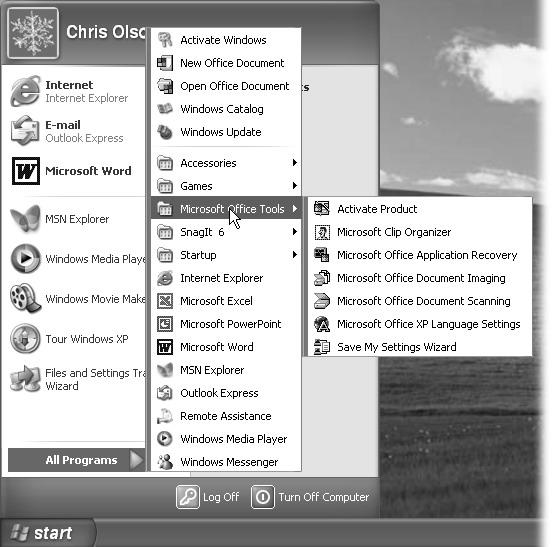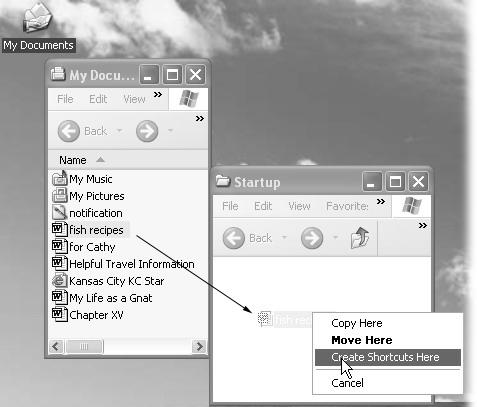For most people, the Start→All Programs command is the most important function of the Start menu. It’s the master list of every program on your computer. (The installer for any new program generally installs its own name in this menu; see Figure 1-7.) You can jump directly to your word processor, calendar, or favorite game, for example, just by choosing its name from the Start→All Programs menu.
Tip
When the Start menu is open, you can open the All Programs menu in a number of ways: by clicking the All Programs menu, by pointing to it and keeping the mouse still for a moment, or by pressing the P and then the right-arrow keys on your keyboard.
Speaking of keyboard fanaticism: Once the programs list is open, you can also choose anything in it without involving the mouse. Just type the first letter of a program’s name—or press the up and down arrow keys—to highlight the name of the program you want. Then press Enter to seal the deal.
Clearly, the graphic designers were on vacation the day Microsoft came up with this one. The All Programs menu appears superimposed on the regular Start menu, adding a third column in a second layer—not the most elegant visual solution, to be sure, but at least easy to find.
The Start→All Programs menu also lists the Startup folder, which contains programs that load automatically every time you start Windows XP. This can be a very useful feature; if you check your email every morning, you may as well save yourself a few mouse clicks by putting your email program into the Startup folder. If you spend all day long word processing, you may as well put Microsoft Word or WordPerfect in there.
In fact, although few PC users suspect it, what you put into the Startup folder doesn’t have to be an application. It can just as well be a certain document you consult every day. It can even be a folder or disk icon whose window you’d like to find open and waiting each time you turn on the PC. (The My Documents folder is a natural example.)
Figure 1-7. The Start→All Programs menu may list the actual application (such as Microsoft Word) that you can click to launch the program. But it may also list a program group, a submenu that lists everything in a particular application folder. Some software programs install a folder on the All Programs menu, like the Office Tools folder shown here, that contains commands for launching the software, uninstalling the software, running specific utilities, opening the help files, and so on.
Of course, you may be interested in the Startup folder for a different reason: to stop some program from launching itself. This is a particularly common syndrome if somebody else set up your PC. Some program seems to launch itself, unbidden, every time you turn the machine on.
Tip
All kinds of programs dump components into this folder. Over time, they can begin to slow down your computer. If you’re having trouble determining the purpose of one startup program or another, visit this Web page, which provides a comprehensive list of every startup software nugget known, with instructions for turning off each one: http://www.sysinfo.org/startupinfo.html.
Fortunately, it’s easy to either add or remove items from the Startup folder:
Click the Start button. Point to All Programs. Right-click Startup and choose Open from the shortcut menu.
The Startup window opens, revealing whatever is inside.
To delete an icon from this folder, just right-click it, choose Delete from the shortcut menu, and answer Yes to send the icon to the Recycle Bin. Close all the windows you’ve opened and enjoy your newfound freedom from self-launching software. The deed is done.
To add a new icon to the Startup folder, on the other hand, read on.
Navigate to the disk, folder, application, or document icon you want to add to the Startup folder.
Doing so requires familiarity with one of two folder-navigation schemes: My Computer or Windows Explorer. Both are described in the next chapter.
Using the right mouse button, drag the icon directly into the Startup window, as shown in Figure 1-8.
When you release the button, a shortcut menu appears.
Choose Create Shortcuts Here from the shortcut menu.
Close all the windows you’ve opened. From now on, each time you turn on or restart your computer, the program, file, disk, or folder you dragged will open by itself.
Figure 1-8. It’s easy to add a program or document icon to your Startup folder so that it launches automatically every time you turn on the computer. Here, a document from the My Documents folder is being added. You may also want to add a shortcut for the My Documents folder itself, which ensures that its window will be ready and open each time the computer starts up.
Tip
To find out what something is—something in your Start menu, All Programs menu, or indeed anywhere on your desktop—point to it with your cursor without clicking. A small yellow tooltip appears, containing a text description. (If the tooltip doesn’t appear, it might be that the window you’re pointing to isn’t the active window on your desktop. Click the window and then try again.)
Get Windows XP Pro: The Missing Manual, Second Edition now with the O’Reilly learning platform.
O’Reilly members experience books, live events, courses curated by job role, and more from O’Reilly and nearly 200 top publishers.



